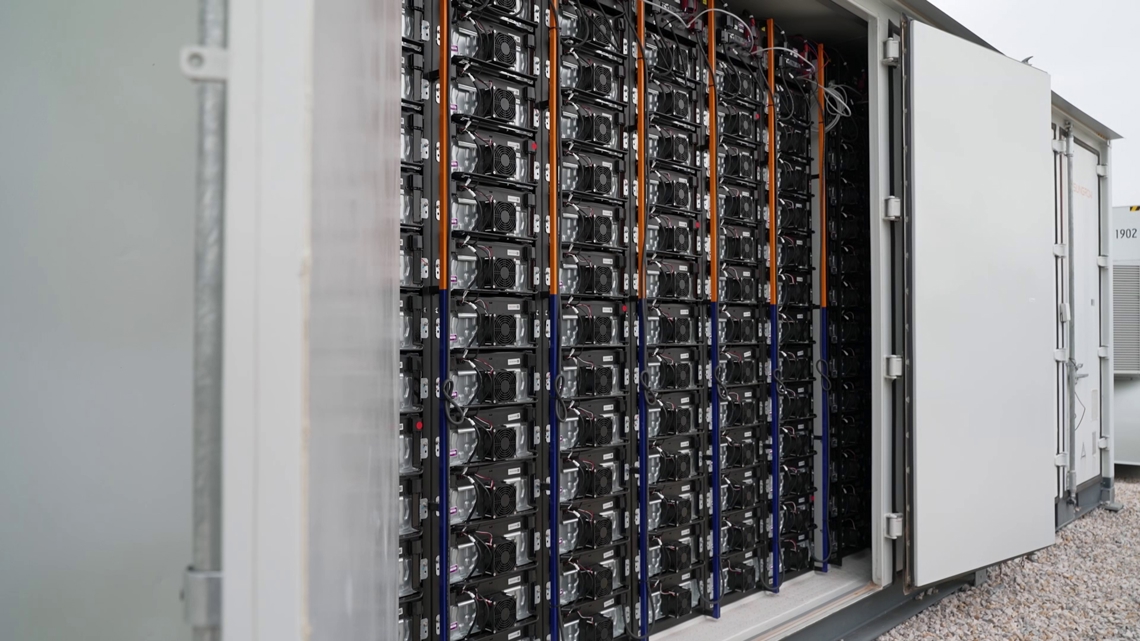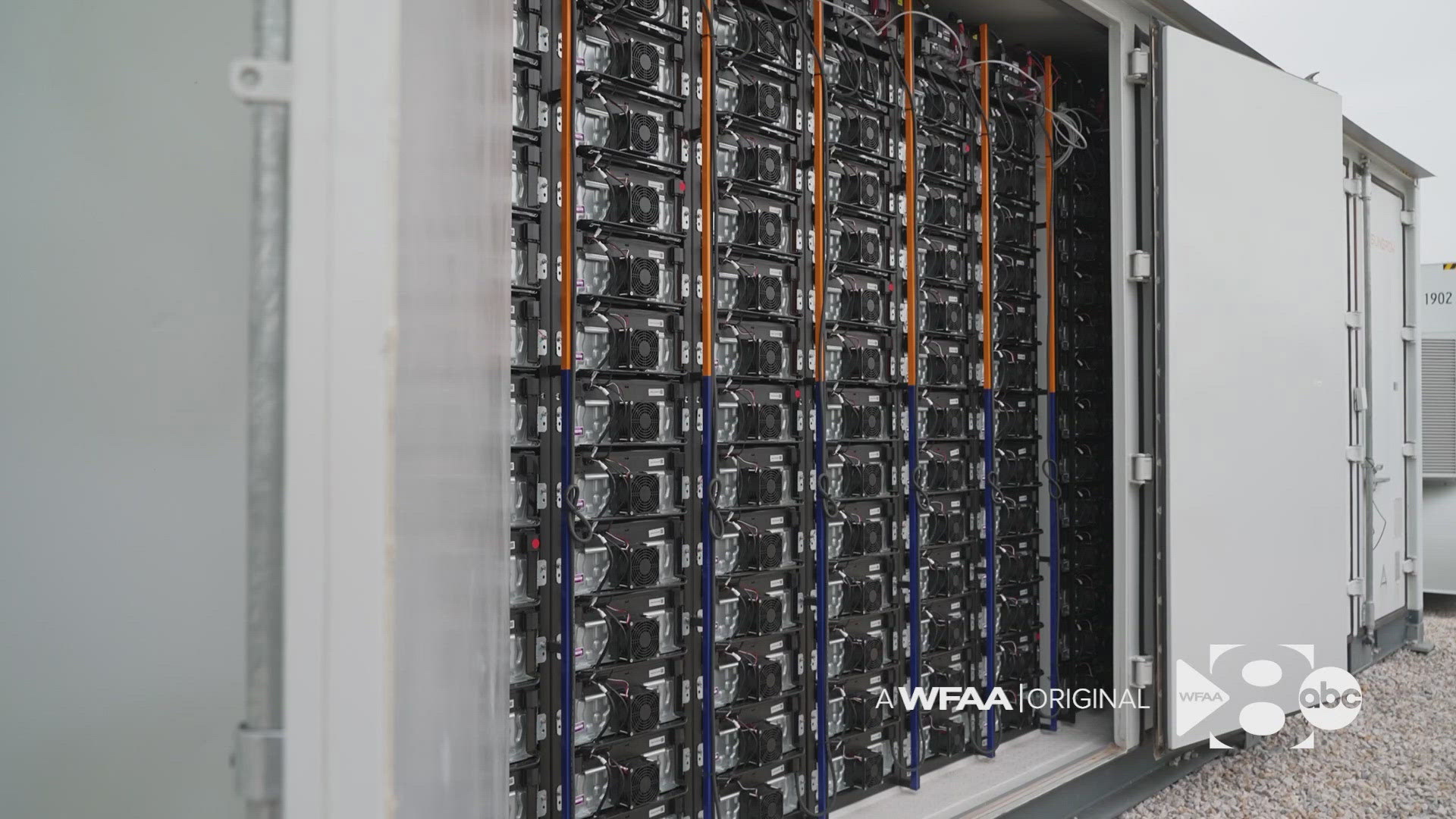FORT WORTH, Texas — Curious cattle lowed at the herd of people examining rows of shipping containers about thirty yards away on an overcast May morning.
A heavy-duty fence surrounds the inconspicuous gray boxes. Air conditioners cooling their precious cargo emit a gentle hum.
The property borders ranchland and an asphalt maker, all about three miles south of Hicks Airfield in Fort Worth. Electricity transmission lines cast a long shadow over the industrial site.
"A lot of people saw, like us, the opportunity to fill a need," Stephanie Smith said, walking the gravel path between the boxes.
As she turned into the array, an engineer unlocked one container to reveal its components: dozens of metal canisters resembling old computer hard drives, with neatly organized wires protruding from their ends.
A "high voltage" sign warns onlookers away from the machines.


"What's happening in Texas is really exciting," Smith said. "I love what batteries can do for the grid."
Smith is chief operating officer at Eolian, which operates the Chisholm Grid battery farm.
Eolian buys power off nearby transmission infrastructure to charge its array when electricity is plentiful and its wholesale price is low. It will sell that stored electricity back to the grid when demand drives up prices.
The process is similar to stock trading.
"You're trying to take advantage of the times when there's extra power, and then you're putting it in the market when the market needs it," Smith said.
Chisholm Grid began charging and discharging about two years ago, making it one of Texas's oldest battery farms.
The industry is growing at an exponential rate, particularly in the Lone Star State.
Combined, Texas's battery energy storage systems can hold about 8 gigawatts of electricity - a 35% capacity increase from January 1, according to data published by Texas's grid operator, ERCOT, and analyzed by WFAA.
There were just a few battery farms in Texas during the February 2021 winter storm, which prompted days-long power outages and killed 246 people.
Battery storage capacity has increased by about 2,500% since February 2021, according to WFAA's analysis of ERCOT and historical data.
"You can see that incident is one of the urgencies that pushed a lot of people to put more energy onto the grid," University of Texas at Arlington professor Chris Boyer said.
Boyer teaches about Texas's power grid at the University of Texas at Arlington, which has developed a degree plan for engineers who want to work with emerging technology in the energy field. Graduates are in high demand, partly because of the growth in the battery storage and renewable energy sectors.
"Energy storage is a relatively new field for the utility space," Boyer said. "Just in the last two years, the amount of energy storage has doubled. Today, it's about five percent of our generation capacity."
Electric vehicle makers have led the research and development of battery storage systems. The cells inside the shipping containers at Chisholm Grid are similar to those inside an EV.
Economics has driven the industry's growth. Batteries are simultaneously becoming more efficient and cheaper to make, especially as the price of Lithium falls, Smith and Boyer said.
Perhaps most importantly, Texans' seemingly unquenchable thirst for electricity has lured battery operators to the Lone Star State.
"Battery energy projects are making good returns," Boyer said, adding that investors can recoup the money they spend on a battery storage facility in about five years.
Energy storage systems fill a summertime gap between 7 p.m. and 9 p.m. when Texans are running their air conditioners, but the sun is setting behind solar panels and coastal winds are not yet blowing turbines.
In the past, Texas paid natural gas plants to wait on standby for this time.
The move ensured gas plants would be operable during tight grid conditions, but effectively took gas plants out of the market during the day. A generator cannot operate normally and sit in reserve at the same time.
Aurora Energy researchers found that batteries are replacing natural gas plants in the reserve market, allowing the thermal generators to participate in the more lucrative real-time market.
During a cold snap in January 2024, the analysts found batteries saved Texans about $750 million in just two days by freeing up gas plants to produce electricity as demand warranted. The increased competition in the real-time market kept wholesale electricity prices low.


"Everyone can play their part in the market," Smith said. "Gas is reliable. It's there all the time. Batteries, for example, can - instead of gas - sit in reserve, ready to jump in when you need them at a microsecond's notice."
"Because batteries have a limited amount of time they can power or charge, it makes more sense for us to be the ones in reserve," she continued.
Batteries can also respond to problems faster than gas plants, which take a few minutes to 'fire up.'
"They don't have mechanical parts. There's no moving," Boyer said. "You just turn them on or turn them off, when needed. They're readily and instantaneously available."
In the spring, ERCOT projected Texas's battery storage capacity could grow to about 16 gigawatts by mid-2025.
Monday, Jupiter Power connected a battery farm in Houston to the grid. It is the first grid-scale energy storage facility in the city. On the same day, batteries discharged more electricity to the Texas grid than ever before.
Researchers and startup companies are also exploring ways to involve homeowners in the battery boom. A program currently in its pilot phase would allow Texans to sell the power they collect from rooftop solar panels and store it in home-scale batteries, such as Tesla's Powerwall.
Eolian's Chisholm Grid could soon expand, too.
"With the amount of demand that's growing here in Texas, we need everybody coming together," Smith said. "We need all the megawatts."

